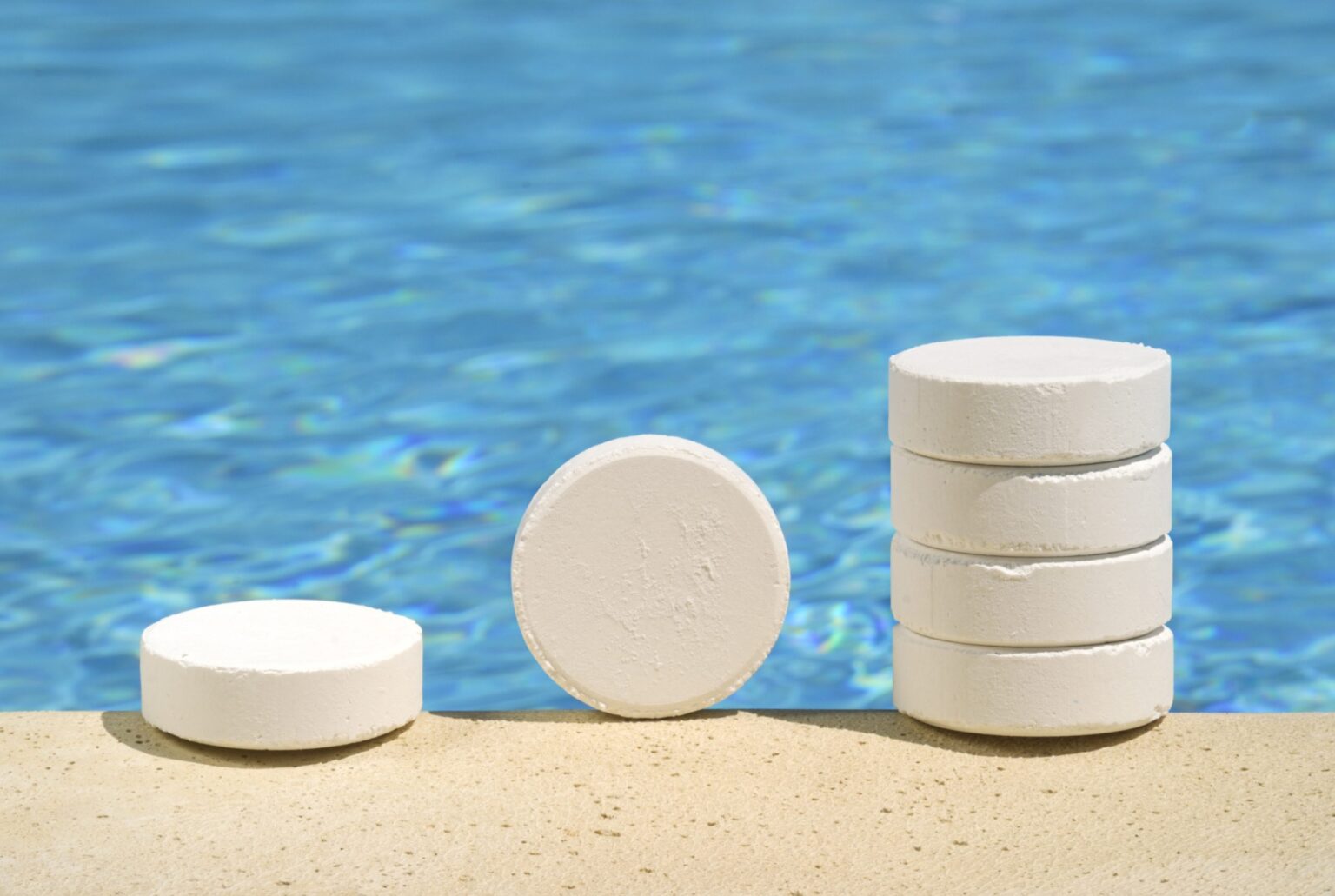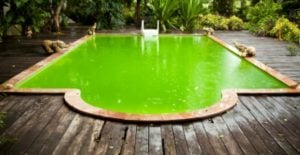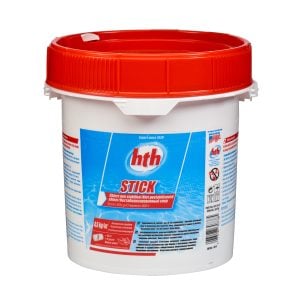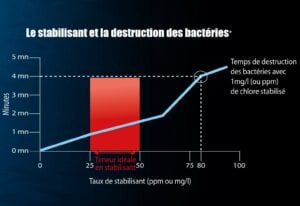Swimming pool chlorine all information and FAQs.
Swimming pool chlorine ensures hygiene, what exactly is chlorine?
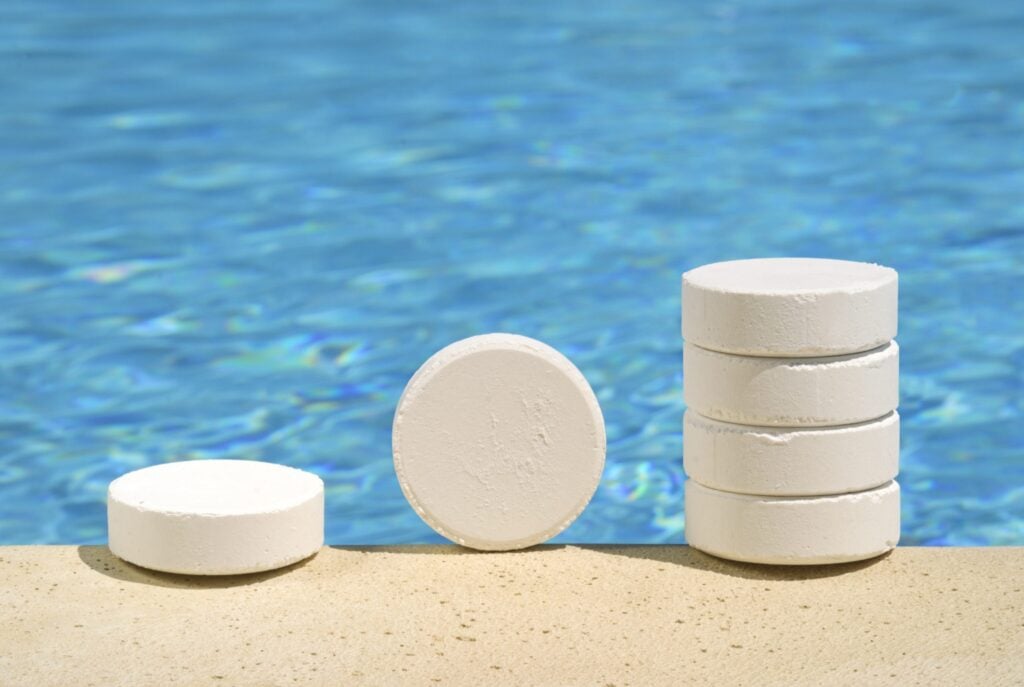
Swimming pool is chlorine a product for disinfecting water in swimming pools and jacuzzis. The active substance is hypochlorite. Chlorine is available in tablets, granules and liquid form.
It pool chlorine ensures the disinfection of the swimming pool water and thus for pure and clear swimming pool water.
You use chlorine to maintain swimming pool water. Swimming pool chlorine is available in different shapes, packaging and consists of different raw materials. The products are composite products, the concentration is expressed in % active chlorine components.
Comparable products are high concentration alcohol, hydrogen peroxide (oxygen water), acetic acid or eg glutaraldehyde. In other words, these are also disinfectants, but you do not only use these substances for pool water disinfection.
What types of pool chlorine are there?
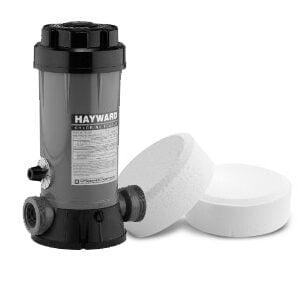
Chlorine for swimming pool is available in 3 forms:
-
- tablets (200g) or sticks (300g)
- in granulate / powder / granules
- and in liquid form
Chlorine tablets or HTH chlorine sticks are usually placed in skimmers. For example, the swimming pool chlorine dissolves slowly and thus ensures continuous disinfection of the swimming pool water in one chlorine pool. You can also use the chlorine tablets in dispensers such as the Hayward chlorine dispenser.
Chlorine granules or powder are used as chlorine shock. Chlorine granules can be sprinkled directly into the pool when the water is warm. Is the pool water cold you better it chlorine powder first dissolve in a bucket of warm water and then dose.
The chemical composition differs from product to product.
Here is an overview of the different compositions:
-
- Trichloroisocyanuric acid 90% – organic
- Dichloroisocyanuric acid 56% or 60% – organic
- Calcium hypochlorite 69% – inorganic
- Sodium hypochlorite 13.5% - liquid chlorine (also known as sodium hypochlorite - eau de javel or simply called JAVEL)
SUMMARIZED the 3 types of chlorine at a glance :
-
- Chlorine granulate do you use for one chlorine shock, to chlorinate in very hot weather or to disinfect very locally on, for example, a staircase.
- It liquid chlorine you use almost exclusively for automatic pool water treatment and in public swimming pools.
- HTH Pastilles 7g are mostly used in jacuzzis or in chlorine systems to create a chlorine solution
- Chlorine tablets are usually in 200g tabs or e.g. in cylindrical 300g chlorine sticks form.
Frequently asked questions about chlorine in the swimming pool
- For private pools there should be 1 to 2 grams per 1000 L of water be present, this is1 and 2ppm.
- In a public swimming pool the free chlorine content has been set at minimum 0.5 gram per 1000L water or 0.5ppm, the bound chlorine may be MAXIMUM 0.6 gram per 1000L water or 0.6ppm (VLAREM II)
How much should it chlorine content in the swimming pool be right now. This partly depends on whether you are disinfecting a private swimming pool or if the chlorine is measured in a public swimming pool.
pH value – the most important parameter is the pH value of the pool water. If the pH is too low or too high, the chlorine in the pool water will not work properly. Correctly measure the acidity of your pool water with a pH meter.
According to the Belgian VLAREM II legislation, a public swimming pool minimum 0.5ppm (0.5 grams per 1000L) FREE chlorine be present and maximum 0.6ppm (0.6 grams per 1000L) BOUND chlorine.
You can measure the free chlorine with a photometer such as the Lovibond PC Checkit or the Hanna Poolline photometer. During the measurement, you measure the total chlorine and the combined chlorine.
FREE CHLORINE = TOTAL CHLORINE – BOUND CHLORINE
By public swimming pools we mean:
- public inside and outside swimming pools
- An Hotel swimming pool
- swimming pools in wellness centers
Below is an overview of the regulations for the chlorine content:
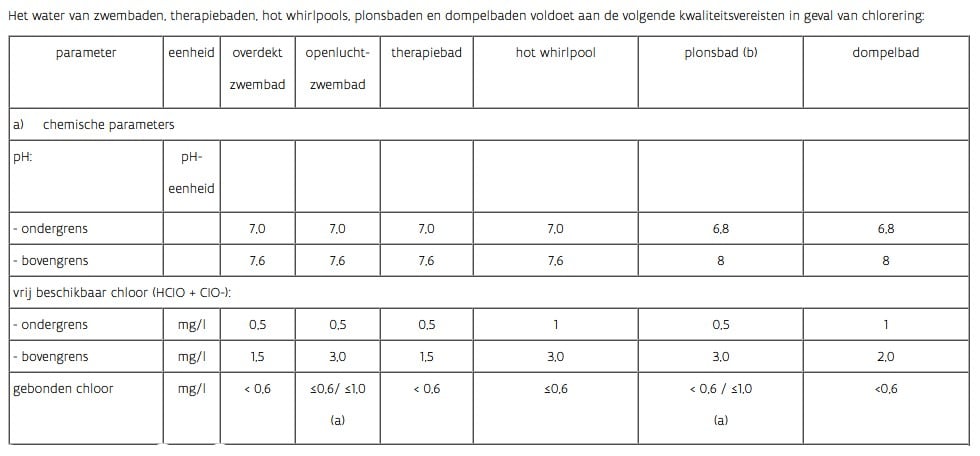
You measure chlorine immediately chlorine meter these are chlorine test strips, An chlorine pocket meter or a photometer for chlorine. There are several ways to measure the chlorine level in your swimming pool water.
- First of all, you have the quick (but less accurate) way, which is measuring with test strips. With these test strips you can also measure the pH value of your swimming pool water at once.
- A second option is to measure the ORP value with the Hanna pocket pH ORP meter. This meter only works in swimming pool water WITHOUT stabilizer/cyanuric acid (so does not work with 200g chlorine tablets, but does with HTH Sticks).
- The last 3rd and most accurate method is with a chlorine measurement with a photometer.
Since 2018, you can also measure and monitor your swimming pool water quality with an APP on your smartphone. The chlorine meter that we are very charmed by is the ONDILO Pool meters
In addition the pH value or also the acidity is the most important parameter. As a result, without a correct pH value, the chlorine will not disinfect properly. It is best to measure the pH with a pH meter.
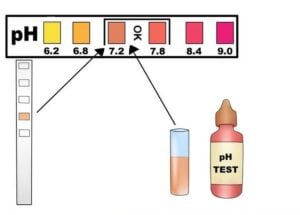
TIP check your pH – A very important tip is the pH value of your swimming pool water. It should be between 7.2 and 7.4. If this is not the case, then your chlorine is not working properly! By dosing the chlorine your pH will generally rise.
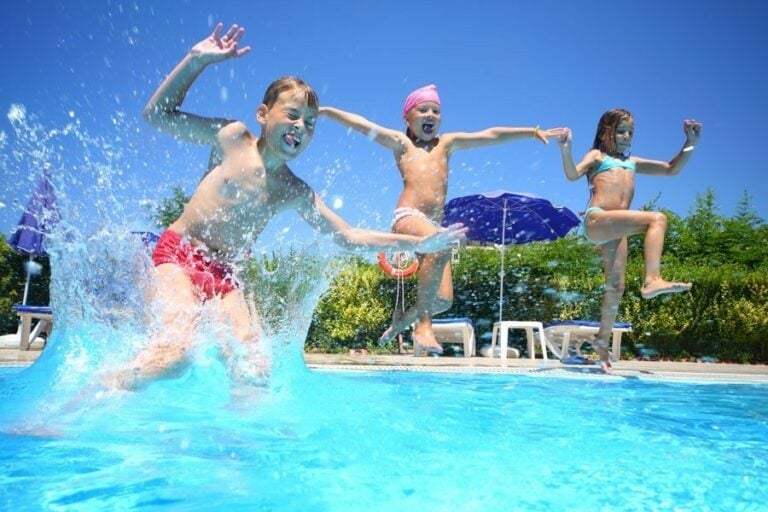
Wait 24 hours after a chlorine shock
After performing a chlorine shock in the pool you can only swim again when the chlorine value has dropped below 3ppm (3 grams per 1000 liters of water) or after at least 24 hours.
Usually this takes 1 to 2 days for an outdoor swimming pool. You can speed up this time by diluting the pool water and thus lowering the chlorine in the water. This can be done, for example, by backwashing the sand filter and adding fresh water.
Even if you leave the pool open without a cover, with the roller shutter open, the sun and the evaporation will help ensure that your chlorine value drops back faster and you can swim again.
You can measure the chlorine value with our Aquacheck 3 in 1 test strips.
TIP : follow always good the recommended dosage and never put chlorine in the pool again. A (too) high concentration of chlorine can damage the swimming pool, the cladding or the installation. Moreover, it then takes longer until the value drops enough to be able to swim back.
For the HTH Chlorine granulate is this 150 grams per 10,000 liters of swimming pool water.
A swimming pool with chlorine in the water very safe because the water of a swimming pool is best disinfected in this way. Chlorine also has the known “deposit” – operation. In concrete terms, this means that dirt that enters the pool is immediately disinfected.
First is the intention of using chlorine in a swimming pool to clean the water keep safe and clean, free of bacteria and pathogenic organisms. Second, when used correctly, chlorine is a safe product. As a third point you can swim in safe and pure pool water. It is extremely important to use the safety instructions and the products correctly when using chlorine. Therefore always follow the recommendations on the label!
Chlorine is toxic, flammable and corrosive. Like many household chemicals, the product is very dangerous if used incorrectly. So respect this one basic safety rules :
- Breath the product not in
- Keep the product in one dry cool room
- Love the product far away from children
- Avoid contact with the skin
- Take the school product not in
- Do not mix chlorine with other chemical products.
- Do not remove the disinfectant from its original packaging
In summary the danger of chlorine mainly lies in its improper use. The product itself is extremely suitable for swimming pool water hygiene.
Chlorine is not good for health - especially the residual products of the disinfection are harmful. It is well known that chlorinated water dry out the skin, cause skin irritation (such as eczema), eye irritation or respiratory tract irritation. On the other hand, the advantage of properly disinfected swimming pool water does not outweigh the disadvantages of chlorine. We can decide that it is real danger for health not in the chlorine but the residual products of the chlorine disinfection.
And that is the real danger: when chlorine in water reacts with other substances such as eg urine, shampoo residues, deodorants, body care products or eg sun cream, it can potentially cause toxic substances.
The New York Times - Karen Weintraub - June 16, 2017
In outdoor swimming pools these potentially toxic substances or chloramines are blown away by the wind, which is why it is extremely important to provide a very good ventilation system in indoor swimming pools.
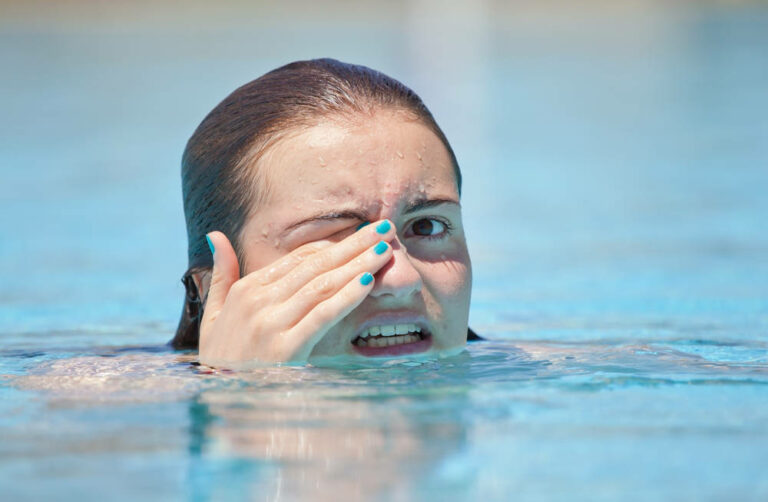
Cause of stinging eyes from chlorine
The main cause of stinging eyes in a swimming pool is an excessive amount of BOUND chlorine (chloramine). Chloramine irritates the mucous membrane of our eyes. This is chlorine that has already broken down dirt particles (urine, sweat, …) or bacteria. This chlorine bonds with this dirt, forms a compound, chloramine and irritates the eyes.
Most chloramines become formed by binding with urine.
Chlorine also dries out, so both the skin but also the eyes will cause a drying effect that can also cause irritation.
Chloramine is heavier than air and thus “hangs” above the surface of the pool water. This is mainly in covered indoor pools. This quickly irritates the eyes.
In open-air swimming pools, this is less of a problem because a breeze quickly blows away these chlorine compounds.
You will also experience less eye irritation from swimming pool chlorine in private swimming pools because the swimming pool is used less intensively. as a result, less dirt enters the pool and less irritating chloramine is formed.
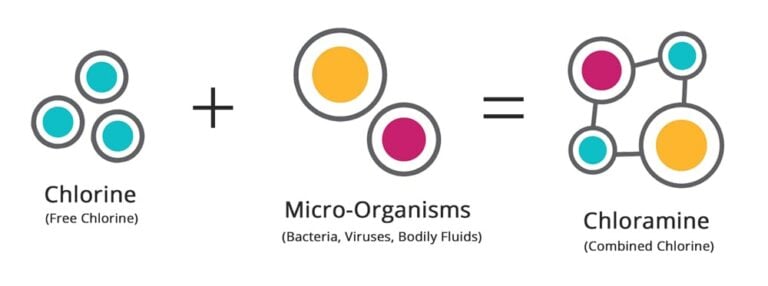
Reducing bound chlorine
The best and fastest way to avoid stinging the eyes amount of BOUND chlorine (chloramines) in the pool water. This can continue to change water, with special activated carbon filters or UV water treatment. The bound chlorine comes from chlorine that has broken down the dirt particles such as sweat, urine and bacteria.
A simple tip to prevent stinging eyes in private swimming pools wearing swimming goggles.
In public swimming pools is the most commonly used technique multilayer filter with Hydro Anthracite as the top filter layer. This is because according to the VLAREM II legislation it is a maximum amount of 0.6ppm (0.6 grams per 1000L water) is allowed.
You can easily measure bound chlorine with our 6 in 1 Test Strips. This allows you to measure total chlorine and free chlorine. The bound chlorine = total chlorine – free chlorine.
Chlorine products dissolved in water react with this water and form hypochlorite (ClO-). This hypochlorite is the active substance (oxidizer) which carries out the disinfection of the swimming pool water.
You can therefore disinfect swimming pool water with various chemical products containing chloride:
- Sodium chloride (NaCl2) – salt – salt electrolysis
- Hydrochloric acid (HCl2) – hydrochloric acid – electrolyte electrolysis
- Chlorine gas (Cl2) – chlorine gas injection via venturi
- Sodium hypochlorite (NaClO) – dosage of Chlorine stable 299B
STABILIZED pool contains chlorine chlorine + UV stabilizer which prevents degradation by the sun , NOT stabilized chlorine contains NO UV stabilizer and will therefore be broken down more quickly by sunlight.
The UV stabilizer will prevent the degradation of the chlorine by the sun's rays. If it is sunny, stabilized chlorine will therefore be broken down less quickly by the sun. Stabilized chlorine will be broken down more quickly by the sun.
The UV stabilizer in swimming pool chlorine is cyanuric acid. Stabilized swimming pool chlorine is based on Trichloro or Dichloro. On the contrary unstabilized chlorine, also inorganic chlorine, does not contain a cyanuric acid stabilizer.
Beware; too high a concentration of cyanuric acid can prevent the proper functioning of the chlorine in swimming pool water.
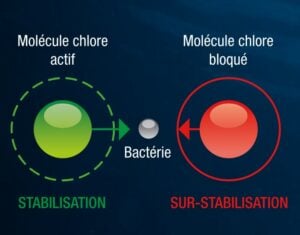
Read all about pool chlorine blockage and how to prevent it here.
Trichloro or Dichloro are difficult words for the common chlorine tablets or chlorine powder that you can find in every department store or in every swimming pool shop.
There exist 2 types of NOT stabilized swimming pool chlorine:
- Liquid Chlorine – Chlorstabil – Sodium Hypochlorite
- HTH chlorine - HTH sticks - Calcium hypochlorite
In public swimming pools it is MANDATORY to work with unstabilised chlorine, which is why liquid chlorine is often used.
The liquid chlorine and acid are usually mixed with a automatic pool water treatment dosed.
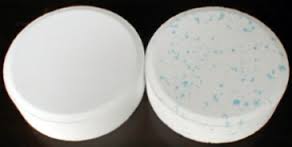
In a very simple way you can see the difference between “ordinary” chlorine tablets 200g and MTF (multifunction) 5 in 1 chlorine tablets. The MTF chlorine tablets have blue dots. In addition to chlorine, these 5 in 1 chlorine tablets contain everything to make your swimming pool water crystal clear and are very easy to use.
-
- Ordinary chlorine tablets consist of only chlorine.
- The 5 in 1 chlorine consists of chlorine – stabilizer – anti alg – flocculant – pH stabilizer
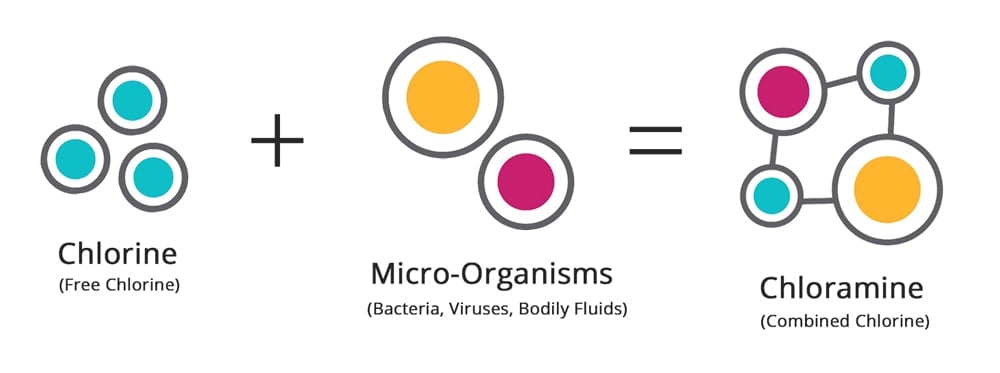
Free chlorine VS bound chlorine
FREE chlorine is chlorine that still available is for breaking down pollution and killing bacteria. BOUND chlorine is chlorine that not available anymore is for purifying swimming pool water.
If you want good purification of the swimming pool water, a sufficiently high presence of FREE chlorine is important for good disinfection. Pure water no longer contains bacteria and is crystal clear.
In private swimming pools, the measurement is less strict and we recommend a total chlorine value between 1 and 2 PPM (1 to 2 grams per 1000L of water). In public swimming pools, writes the VLAREM legislation stipulates a strict minimum of 0.5ppm FREE chlorine (5 grams per 1000L water). For the BOUND chlorine is the maximum laid down by the VLAREM legislation on 0.6ppm.
SOURCE : Article 5.32.8.1.9 Quality requirements for bath water.
YES you can also use the chlorine for Spa baths, for surface disinfection, for the disinfection of, for example, a steam cabin or for others disinfection applications. We mainly sell the chlorine for swimming pool water disinfection.
Chlorine for disinfecting the swimming pool water, the quay around the swimming pool, surfaces or stables.
Chlorine - product is a very widely used chemical product for the disinfection of swimming pool water, drinking water, cooling water, etc. It occurs in the form of tablets, pastilles, powder, granules and in liquid form.
Bleach (bleach) which you can buy in supermarkets not be used for pool water disinfection. Javel (from the brand Eau De Javel) is a 5% solution of sodium hypochlorite. That is why a bright yellow dye is often added to the chlorine to make it appear more “concentrated”!
In other words, do not use it for your swimming pool and, moreover, the concentration is much too low for a good swimming pool water disinfection.
How do I use chlorine product in my pool?
You can use bleach (chlorine) in various ways to maintain and disinfect swimming pool water. That is why we have made a list of the most common dosing methods for you.
The first method is automatic dosing
Immediately automatic pool water treatment can you doze liquid chlorine. With this water treatment system you will automatically add the chlorine to the swimming pool water with a dosing pump. This is a method that is often used in public swimming pools, hotels and wellness centers and in recent years also frequently in private swimming pools.
2nd way is with chlorine tabs in the skimmer
As a 2nd method you can chlorinate with chlorine tablets. You can place chlorine tabs in the skimmer baskets or in a chlorine dispenser. Because the swimming pool water flows slowly past this tablet, you get a chlorine solution that disinfects the water.
A 3rd possibility is a shock with chlorine powder
A third method is a shock with chlorine powder. With this method you will sprinkle the chlorine granules in the swimming pool. On the other hand, you can also dissolve them in a bucket or watering can of water and then dose them in the swimming pool water.
Finally, it is also possible with a chlorine feeder
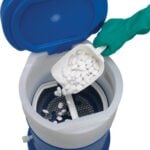
The HTH Pastilles 7g tablets can also be used via a chlorine dosing device. You actually make chlorine on site by dissolving the tablets and water.
You use this chlorine-water mixture for disinfection, for swimming pools, but also for drinking water production, for example.
A variant of this system is the Hayward chlorine dispenser where you can place the large tablets.
TIP!
Dose liquid chlorine or chlorine granulate not in the skimmer. This causes a shock to the filter sand and will loosen all the dirt and release it into the pool. Chlorine tablets be able to in the skimmer being placed.
ATTENTION : Try to keep as much dirt out of the pool as possible. This can be done, for example, with a outdoor shower - garden shower, so by rinsing off before you go into the pool. Or, for example, by covering the swimming pool with a summer cover or a roller shutter.
